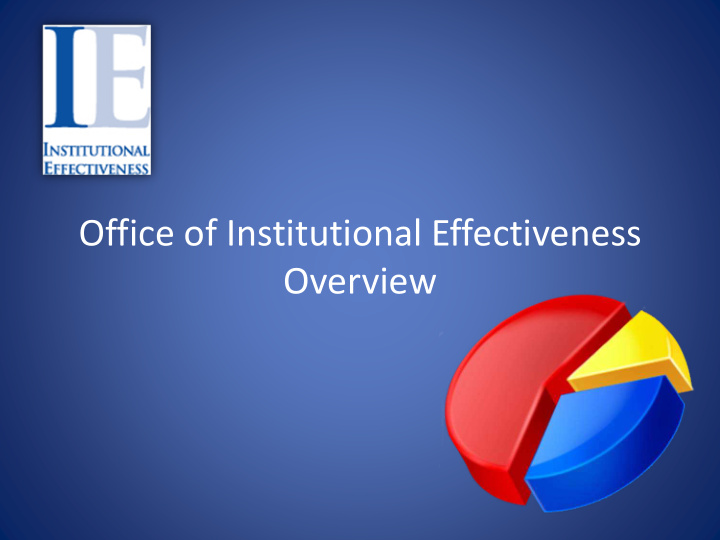



Office of Institutional Effectiveness Overview
Institutional Effectiveness Overview The Office of Institutional Effectiveness functions as the foundation of assessment and evaluation District ‐ wide. IE ensures that all stated strategic goals, objectives, and initiatives of campuses and departments are aligned with the District’s mission, vision, and accrediting body requirements, such as HLC and multiple program ‐ specific accreditations.
IE Spotlight Johnesa Dimicks ‐ District Dean of Institutional Effectiveness Kuda Walker ‐ District Director for Institutional Effectiveness Keri Wallace ‐ Quality Assurance Data Administrator Gonzetta Sellers ‐ Senior Lead Analyst Ronica Hurt ‐ Accreditation Administrator Cynthia Johnson ‐ Brown ‐ General Clerk
Institutional Effectiveness Goals The Office of Institutional Effectiveness commits to the following goals to serve the District: 1. To provide support for continuous quality improvement via assessment planning, research, implementation, and accurate reporting. 2. To strengthen the District’s ability to enable data ‐ driven planning, evidence ‐ based decision ‐ making, and effective evaluation of key operations District ‐ wide. 3. To ensure District ‐ wide alignment of initiatives, core indicators of effectiveness, and student learning outcomes with the strategic plan, chancellor priorities, mission, values, and foundational statements.
How Does IE Get it Done? IE Goals IE Activities • Implementing a District-wide model 1 To provide support for continuous quality improvement via assessment planning, research, implementation, and for institutional effectiveness • Planning and supporting the District- accurate reporting. wide assessment program • Reporting research results to internal and external stakeholders. • Supporting institutional and program 2 To strengthen the District’s ability to enable data-driven planning, evidence-based decision-making, and effective accreditation activities. • Design and administer survey evaluation of key operations District-wide. calendar to collect qualitative data and interests of all stakeholders. • Evaluating organizational processes 3 To ensure District-wide alignment of initiatives, core indicators of effectiveness, and student learning outcomes for quality and effectiveness • Conducting institutional research for with the strategic plan, chancellor priorities, mission, values, and foundational statements. planning and decision-making.
WCCCD Assessment Model The WCCCD Assessment model serves as a holistic, District ‐ wide framework to guide the involvement of all faculty and staff members contributing to WCCCD’s continuous improvement.
Annual Continuous Improvement Cycle
Core Indicators of Effectiveness The core indicators of effectiveness are district ‐ level standards or benchmarks that detail the components of the mission statement in tangible and measurable terms, thus making it possible to assess the degree to which the college’s mission is being achieved. Source: WCCCD’s Holistic Assessment Model Description
Annual District Scorecard
WCCCD Survey Inventory The purpose of the survey inventory calendar is to outline an inventory of surveys and/or routine reports that collect essential data to monitor educational outcomes and quality services.
Surveys and Feedback The Office of Institutional Effectiveness supports District- wide continuous improvement through regular collection of survey and research data from various stakeholders about programs and services.
Statistics and Trend Reports Statistics and Trend Reports are conducted on a routine basis to provide data and information to the campuses, staff, and administrators in a usable format to make informed decisions District ‐ wide.
Fast Facts It is important to provide institutional and research data on an ongoing basis to ensure ongoing feedback and awareness of trends and changes in higher education. IE uses data drops to inform its internal and external community through email, weekend memos, and the website.
Environmental Scanning
Contact Information For any questions related to the information included in the presentation, please contact Johnesa Dimicks jdimick1@wcccd.edu
Recommend
More recommend